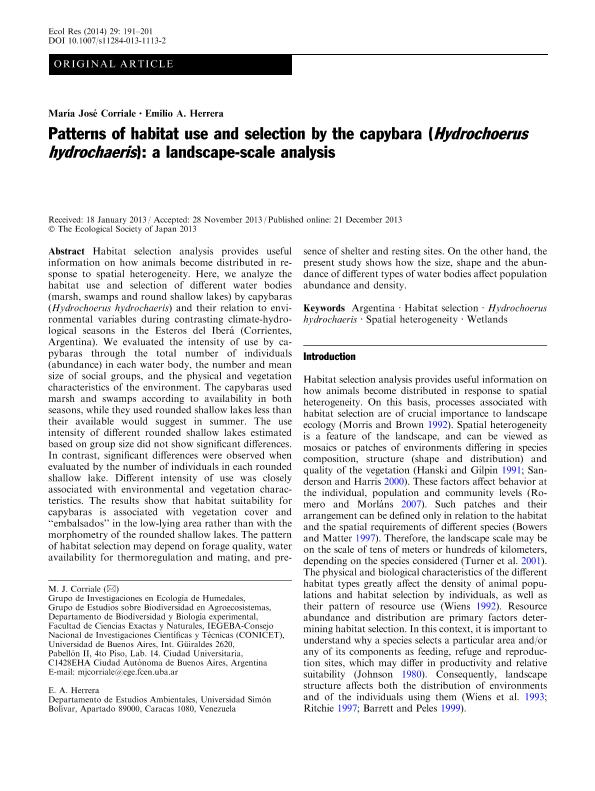Mostrar el registro sencillo del ítem
dc.contributor.author
Corriale, Maria Jose

dc.contributor.author
Herrera, Emilio A.

dc.date.available
2017-07-05T17:53:18Z
dc.date.issued
2014-03
dc.identifier.citation
Corriale, Maria Jose; Herrera, Emilio A.; Patterns of habitat use and selection by the capybara (Hydrochoerus hydrochaeris): a landscape-scale analysis; Springer Tokyo; Ecological Research; 29; 2; 3-2014; 191-201
dc.identifier.issn
0912-3814
dc.identifier.uri
http://hdl.handle.net/11336/19607
dc.description.abstract
Habitat selection analysis provides useful information on how animals become distributed in response to spatial heterogeneity. Here, we analyze the habitat use and selection of different water bodies (marsh, swamps and round shallow lakes) by capybaras (Hydrochoerus hydrochaeris) and their relation to environmental variables during contrasting climate-hydrological seasons in the Esteros del Ibera´ (Corrientes, Argentina). We evaluated the intensity of use by capybaras through the total number of individuals (abundance) in each water body, the number and mean size of social groups, and the physical and vegetation characteristics of the environment. The capybaras used marsh and swamps according to availability in both seasons, while they used rounded shallow lakes less than their available would suggest in summer. The use intensity of different rounded shallow lakes estimated based on group size did not show significant differences. In contrast, significant differences were observed when evaluated by the number of individuals in each rounded shallow lake. Different intensity of use was closely associated with environmental and vegetation characteristics. The results show that habitat suitability for capybaras is associated with vegetation cover and ‘‘embalsados’’ in the low-lying area rather than with the morphometry of the rounded shallow lakes. The pattern of habitat selection may depend on forage quality, water availability for thermoregulation and mating, and presence of shelter and resting sites. On the other hand, the present study shows how the size, shape and the abundance of different types of water bodies affect population abundance and density.
dc.format
application/pdf
dc.language.iso
eng
dc.publisher
Springer Tokyo

dc.rights
info:eu-repo/semantics/openAccess
dc.rights.uri
https://creativecommons.org/licenses/by-nc-sa/2.5/ar/
dc.subject
Argentina
dc.subject
Habitat Selection
dc.subject
Hydrochoerus Hydrochaeris
dc.subject
Spatial Heterogeneity
dc.subject
Wetlands
dc.subject.classification
Ecología

dc.subject.classification
Ciencias Biológicas

dc.subject.classification
CIENCIAS NATURALES Y EXACTAS

dc.title
Patterns of habitat use and selection by the capybara (Hydrochoerus hydrochaeris): a landscape-scale analysis
dc.type
info:eu-repo/semantics/article
dc.type
info:ar-repo/semantics/artículo
dc.type
info:eu-repo/semantics/publishedVersion
dc.date.updated
2017-07-05T15:02:18Z
dc.identifier.eissn
1440-1703
dc.journal.volume
29
dc.journal.number
2
dc.journal.pagination
191-201
dc.journal.pais
Japón

dc.journal.ciudad
Tokyo
dc.description.fil
Fil: Corriale, Maria Jose. Consejo Nacional de Investigaciones Científicas y Técnicas. Oficina de Coordinación Administrativa Ciudad Universitaria. Instituto de Ecología, Genética y Evolución de Buenos Aires. Universidad de Buenos Aires. Facultad de Ciencias Exactas y Naturales. Instituto de Ecología, Genética y Evolución de Buenos Aires; Argentina
dc.description.fil
Fil: Herrera, Emilio A.. Universidad Simón Bolívar; Venezuela
dc.journal.title
Ecological Research

dc.relation.alternativeid
info:eu-repo/semantics/altIdentifier/doi/http://dx.doi.org/10.1007/s11284-013-1113-2
dc.relation.alternativeid
info:eu-repo/semantics/altIdentifier/url/https://link.springer.com/article/10.1007%2Fs11284-013-1113-2
Archivos asociados
